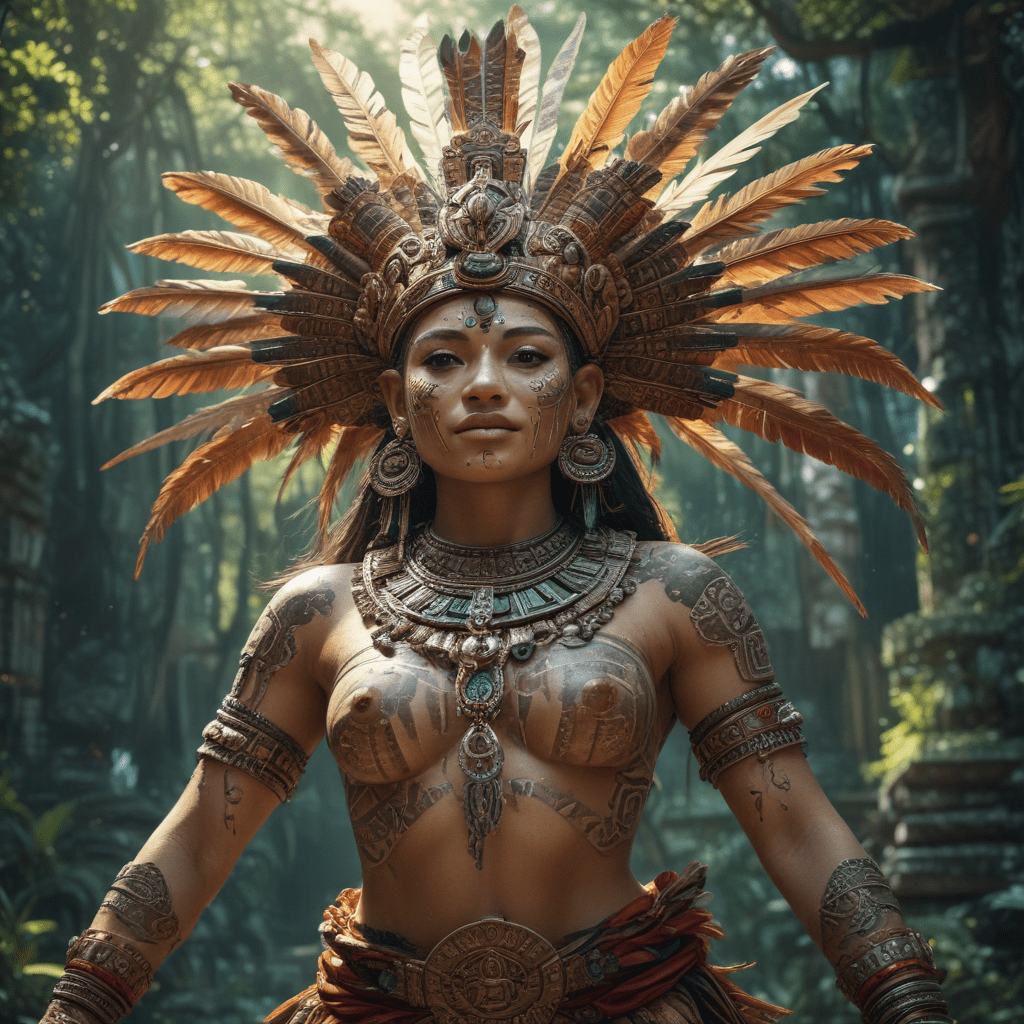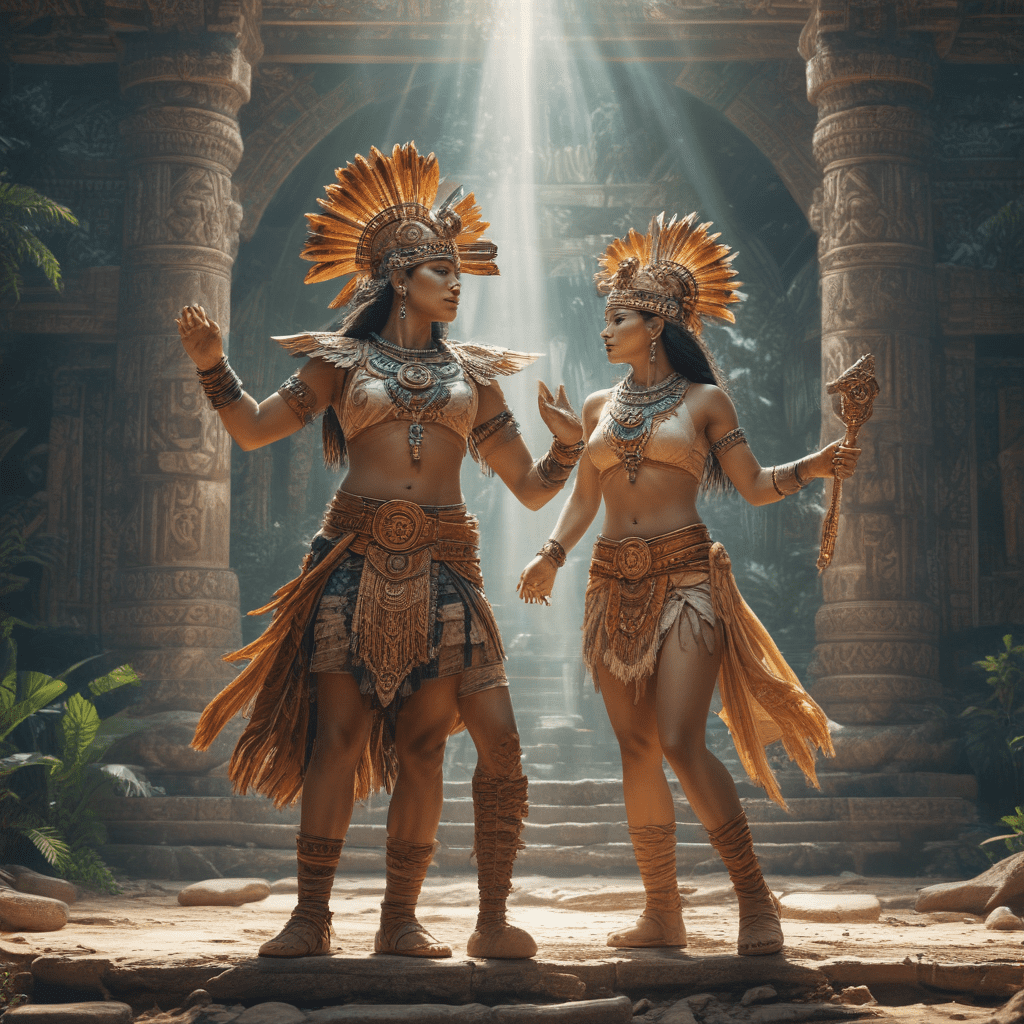Introduction: Exploring the Enchantment of Mayan Mythology
The ancient Maya, with their profound knowledge of astronomy, mathematics, and art, left behind a rich legacy of mythology. Their myths, passed down through generations, provide a window into their beliefs, values, and understanding of the world around them. This captivating realm of Mayan folklore is filled with extraordinary creatures, each playing a unique role in shaping the narrative of their vibrant culture.
The Allure of Mayan Myths: A Glimpse into Ancient Beliefs
Mayan myths offer more than just captivating stories; they unveil the intricate tapestry of Mayan beliefs. These narratives served as a means to explain natural phenomena, guide moral conduct, and provide solace in the face of the unknown. Through these myths, the Maya explored their relationship with the cosmos, the delicate balance of nature, and the complexities of human existence.
The Rich Tapestry of Mayan Creatures: From Fearsome to Benevolent
The pantheon of Mayan creatures is as diverse as it is fascinating. From fearsome deities to benevolent protectors, each creature embodies specific characteristics and embodies profound symbolism. The jaguar, revered for its strength and prowess, symbolizes power and leadership. The feathered serpent, a celestial being, represents the connection between the earth and the heavens. These mythical figures played pivotal roles in shaping the cultural and spiritual landscape of the Maya.
The Importance of Animals in Mayan Culture: Symbols and Significance
Animals held immense significance in Mayan culture, often serving as intermediaries between the human and the divine. The quetzal, a resplendent bird with vibrant emerald plumage, was considered sacred, symbolizing freedom and spiritual enlightenment. The jaguar, with its stealth and power, was associated with royalty and the elite. Through their symbolic associations, animals played a crucial role in shaping Mayan rituals, art, and societal structures.
The Avian Guardians of the Sky: The Quetzal and Its Mystical Powers
The quetzal, with its iridescent green plumage and flowing tail feathers, was held in the highest regard by the Maya. This magnificent bird was believed to be a messenger between the gods and humans, carrying prayers and offerings to the heavens. Its association with the wind and the sky further cemented its mystical status. The quetzal's feathers, prized for their beauty and rarity, adorned the headdresses of rulers and priests, symbolizing their connection to the divine.
The Jaguar's Prowess: A Symbol of Strength and Majesty
The jaguar, with its sleek, muscular form and piercing gaze, commanded respect and awe in Mayan society. Revered as a symbol of power, strength, and royalty, the jaguar was often depicted in art, architecture, and mythology. Its association with the night and the underworld further enhanced its mystical aura.
The jaguar's prowess as a hunter earned it the admiration of the Maya, who saw in it a reflection of their own warrior spirit. Its ability to move silently and strike with lightning speed made it a formidable predator, inspiring both fear and respect. In Mayan mythology, the jaguar was often depicted as a companion or alter ego of powerful deities, such as the sun god and the god of war.
The Serpent's Enigmatic Presence: A Figure of Transformation and Knowledge
The serpent, with its serpentine form and capacity for shedding its skin, held a complex and multifaceted significance in Mayan culture. It symbolized transformation, rebirth, and the cyclical nature of life and death. The serpent was also associated with knowledge, wisdom, and fertility.
In Mayan mythology, the serpent played a prominent role in creation myths, often appearing as a primordial being or a guardian of the underworld. The feathered serpent, a hybrid creature with feathers and scales, was a particularly revered figure, representing the connection between the earth and the heavens. The serpent's ability to shed its skin was seen as a metaphor for spiritual renewal and the ability to transcend the limitations of the physical world.
Mythical Hybrids and Supernatural Beings: Blending the Earthly and the Divine
Mayan mythology is replete with fascinating hybrid creatures that blend the characteristics of different animals and supernatural beings. These creatures often served as intermediaries between the human and the divine, embodying the complex relationship between the natural world and the realm of the gods.
One notable example is the wayak, a mythical creature with the body of a monkey and the head of a human. The wayak was believed to be a mischievous trickster who inhabited the forests and played pranks on unsuspecting travelers. Another fascinating hybrid is the cipactli, a sea monster with the body of a crocodile and the head of a fish. The cipactli was associated with the primordial waters and the creation of the world.
Theories on the Origins of Mayan Myths: Unveiling the Enigmatic Past
The origins of Mayan myths remain shrouded in mystery, but scholars have proposed various theories to explain their emergence. Some believe that these myths evolved from the Maya's observations of the natural world, while others suggest that they were influenced by contact with other Mesoamerican cultures.
One theory posits that Mayan myths originated from the Maya's profound understanding of astronomy. The complex movements of celestial bodies, such as the sun, moon, and stars, may have inspired the creation of myths about deities associated with these celestial phenomena. Another theory suggests that Mayan myths were influenced by the agricultural practices of the Maya. The cyclical nature of planting, harvesting, and the changing seasons may have given rise to myths about gods associated with fertility and the underworld.
The Enduring Legacy of Mayan Folklore: Cultural Preservation and Inspiration
Mayan folklore continues to captivate and inspire people around the world, offering a glimpse into the rich cultural heritage of this ancient civilization. Through their myths, the Maya have left an enduring legacy that celebrates their connection to nature, their reverence for the divine, and their capacity for imagination.
Mayan myths have also played a crucial role in preserving the cultural identity of the Maya, who continue to draw inspiration from these stories in their art, music, and religious practices. The preservation of Mayan folklore is essential for understanding the complex history and worldview of this remarkable civilization.
FAQ
What are some of the most famous Mayan myths?
- The Popol Vuh: The creation myth of the Maya, which tells the story of the gods' attempts to create humans.
- The Hero Twins: The story of two brothers who descend into the underworld to defeat the lords of Xibalba.
- The Maize God: The myth of the god who sacrificed himself to provide humans with maize, their staple food.
What are the main sources of Mayan myths?
- The Popol Vuh: The most important surviving text of Mayan mythology.
- The Dresden Codex: A pre-Columbian book that contains illustrations and hieroglyphic writing related to Mayan mythology.
- The Madrid Codex: Another pre-Columbian book that contains information about Mayan mythology and rituals.
How do Mayan myths reflect the beliefs and values of the Maya?
Mayan myths reflect the Maya's beliefs about the origin of the universe, the nature of the gods, the importance of agriculture, and the role of humans in the cosmos. They also provide insights into Mayan values, such as the importance of courage, sacrifice, and respect for the natural world.
What is the significance of Mayan myths today?
Mayan myths continue to be an important part of Mayan culture and identity. They provide a source of inspiration for artists, writers, and musicians. They also help to connect the Maya to their ancestors and to their past.


